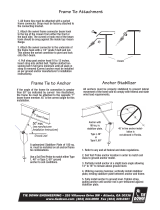Page is loading ...

TIE DOWN ENGINEERING • 255 Villanova Drive SW • Atlanta, GA 30336
www.tiedown.com (404) 344-0000 Fax (404) 349-0401
Stabilization Plates
Class 4B Stabilizer Plate
17-1/2” x 13-1/2”
Galvanized: Part # 59286
Ground Level
"In Line" Installed:
Minimum anchor
length of 36"
In order to prevent lateral movement of manufactured homes
subjected to high wind loads and to comply with HUD’s Wind
Zone I, II, & III requirements, all lateral frame ties must be
attached to a properly stabilized ground anchor. (Two approved
methods illustrated below.)
Anchor Stabilizer
Stabilizer Plate Installation
1. Refer to any and all local, state and federal regulations.
2. Use the Soil Test Probe at the anchor location in order to
match soil class with the anchor/stabilizer.. (See Page 11)
3. Partially install anchor to allow 14” to 16” remaining above
ground level.
4. Utilizing oversized hammer, vertically install stabilizer plate,
nesting anchor rod in between formed channels on outside
of stabilizer plate (between anchor and frame).
5. Fully install anchor so that head is at the surface of the soil
(1” tolerance, if necessary) and pretension anchor until
touching stabilizer plate.
Horizontal Installation
Vertical Installation
2a
2b 2c
1a
1b
Anchor Installation
1a. Position anchor at a slight back angle 10 degrees so
that when fully installed, the anchor head will be inside
any skirting or side wall.
1b. For vertical or (uplift anchorage), fully drive anchor into
the ground. Attach and pretension strap until anchor
begins to pull up and tight under side wall of unit.
2a For Horizontal or (frame tie anchorage), install anchor
to 2/3 depth.
2b. Then install stabilizer vertically within 3-4” of anchor shaft,
parallel to wall of home. Drive anchor the remainder of the way
into the ground and attach strap.
2c. Pretension strap to pull anchor rod against stabilizer plate with
head slightly over top of plate.
/


